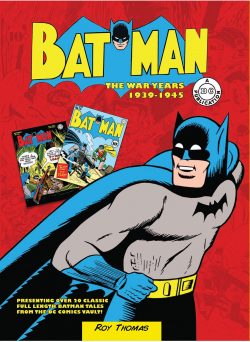

By Bob Kane & Bill Finger with Gardner Fox, Joe Greene, Don Cameron, Alvin Schwartz, Sheldon Moldoff, Jerry Robinson, George Roussos, Fred Ray, Jack & Ray Burnley, Dick Sprang, Stan Kaye, Stan Kaye, Jack Kirby, Ed Kressey & various: curated and edited by Roy Thomas, (Chartwell Books)
ISBN: 978-0-7858-3283-6 (HB)
Win’s Christmas Gift Recommendation: Evergreen Action Adventure… 10/10
March 2019 saw the 80th anniversary of Batman‘s debut in Detective Comics #27. About one year after that dynamic debut his resounding growth in popularity resulted in the launch of Batman #1 (cover-dated “Spring†and released on April 25th, 1940). At that time, only his precursor and stablemate Superman was more successful…
Created a year after and in response to the furore generated by the Man of Steel, “The Bat-Man†(and latterly Robin, the Boy Wonder) confirmed DC/National Comics as the market frontrunner and conceptual leader of the burgeoning comicbook industry.
Having established the parameters of the metahuman with their Man of Tomorrow, the physical mortal perfection and dashing derring-do of the strictly-human Dynamic Duo rapidly became the swashbuckling benchmark by which all other four-colour crimebusters were judged.
However, once the war in Europe and the East snared America’s consciousness, crime and domestic deviltry increasingly gave way to combat and espionage themes. Patriotic imagery dominated most comicbook covers – if not interiors – and the USA’s mass-publishing outfits geared up for a seemingly inevitable conflict.
I feel – like many others of my era and inclinations – that superhero comics were never more apt or effective than when whole-heartedly combating global fascism with explosive, improbable excitement courtesy of a myriad of mysterious, masked marvel men. I have similar thoughts about the early 1970s “relevancy periodâ€, when my masked miracle men turned to tackling slum landlords, super-rich scum, social injustice, crushing poverty and environmental issues: at least we won that one and don’t have to face real atrocities like that anymore…
All the most evocatively visceral moments of the genre seem to come when gaudy gladiators soundly thrashed – and I hope you’ll please forgive the appropriated (but now truly offensive) contemporary colloquialism – “Nips and Krautsâ€.
A companion to volumes starring Superman and Wonder Woman, Batman: The War Years 1939-1945 is superb hardcover archive curated by comicbook legend Roy Thomas, exclusively honing in on the Gotham Gangbusters’ euphoric output from those war years, even though in those long-ago dark days, comics creators were wise enough to offset and counterbalance their tales of espionage and imminent invasion with a barrage of home-grown threats as well as gentler or even more whimsical four-colour fare…
Past master of WWII-era material Thomas opens this tome with scene-setting Introduction Batman: The War Years and prefaces each chapter division with an essay offering tone and context before the four-colour glories commence with Part 1: From Perfidy to Pearl Harbor…
Following the cover to Detective Comics #27, the first the Dark Knight story offers is the ‘Case of the Chemical Syndicate!’ by Bob Kane and his close collaborator Bill Finger. The spartan, understated yarn introduces dilettante criminologist and playboy wastrel Bruce Wayne, drawn into a straightforward crime wherein a cabal of industrialists are successively murdered. The killings stop only when an eerie figure dubbed “The Bat-Man†intrudes on Police Commissioner Gordon‘s stalled investigation and ruthlessly deals with the hidden killer.
Most of the early tales were untitled, but for everyone’s convenience have in later years been given descriptive appellations by the editors, and were teeming with intriguing extras.
Cover-dated November 1939, Detective Comics #33 featured Gardner Fox & Kane’s (with lifetime ghost-artist Sheldon Moldoff quietly toiling on in unsung anonymity with the named creator) ‘The Batman Wars Against the Dirigible of Doom’: a blockbusting disaster thriller which just casually slips in the secret origin of the Gotham Guardian, as mere prelude to intoxicating air-pirate adventure…
With backgrounds inked by new kid Jerry Robinson, the Grim Detective hunted all-pervasive enemy agents in Finger & Kane’s ‘The Spies’. They ultimately prove no match for the vengeful Masked Manhunter in #37.
The covers for Detective Comics #38 (April 1940 and introducing Robin) and Batman #1 (Spring 1940) then precede Finger, Kane, Robinson & George Roussos’ ‘The Strange Case of the Diabolical Puppet Master’: an eerie episode of uncanny mesmerism and infamous espionage first seen in Batman #3 (Fall 1940).
The all-out action continues with a magnificent horrific Joker jape from Detective Comics #45 (November 1940) as ‘The Case of the Laughing Death’ displays the Harlequin of Hate undertaking a campaign of macabre murder against everyone who has ever defied or offended him. Apart from its release date, the wartime connection comes through the catastrophic climax aboard a ship under full steam…
Detective #55 (September 1941, by Finger, Kane, Robinson & Roussos) favours a back-to-basics approach with spectacular mad scientist thriller ‘The Brain Burglar’ as diabolical Dr. Deker plunders the thoughts and inventions of patriotic armaments inventors.
From Batman #8 (newly-promoted to bi-monthly just as the nation began paper-rationing), cover-dated December 1941-January 1942, comes a then-rare foray into science fiction as a scientist abused by money-grubbing financial backers turns himself into a deadly radioactive marauder in ‘The Strange Case of Professor Radium.’ This tale was later radically revised and recycled by Finger & Kane as a sequence of the Batman daily newspaper strip…
This initial section then closes with the cover to Batman #10 before neatly segueing into Part 2: The Home Front War: a section heavy on the unforgettable patriotic covers crafted by Fred Ray, Jack Burnley, Jerry Robinson and others: preceded here by a context-establishing briefing from Thomas.
As the heroes’ influence expanded, new talent joined the stable of creators. Jerry Robinson had already worked with writer Bill Finger and penciller Bob Kane, and during this period more scripters gradually joined the ever-expanding team to detail morale-boosting adventures during the darkest days of World War II.
I’m certain it’s no coincidence that many of these Golden Age treasures are also some of the best and most reprinted tales in the Batman canon. With Finger at a peak of creativity and production, everybody on the Home Front was keen to do their bit – even if that was simply making kids of all ages forget their troubles for a while…
Beginning with a gallery consisting of World’s Finest Comics #5. 6 and 7 (Ray), Detective #64 and 65 (Robinson, with Joe Simon & Jack Kirby pitching in on the latter) and Batman #12 (Robinson & Roussos), the story portion then offers the astounding case of ‘The Harlequin’s Hoax!’ (Detective #69 November 1942) with Joseph Greene, Kane, Robinson & Roussos detailing the Joker’s latest escapade, which ends explosively in an aircraft factory…
The chapter ends – following the stunning Robinson cover for Batman#12 – with Don Cameron’s ‘Swastika Over the White House!’ (limned by Jack & Ray Burnley from Batman #14, October/November 1942): a typically rousing slice of spy-busting action readers were gratuitously lapping up at the time.
Part 3: Guarding the Home Front opens with another historically-informative essay – and Jack Burnley’s cover to Batman #15 – before Cameron and those Burnley boys introduce plucky homeless boy Bobby Deen as ‘The Boy Who Wanted to be Robin!’ so badly he became an easy mark for a sinister Svengali…
The same art team illustrated Finger’s powerful propaganda tale ‘The Two Futures’, which examined an America under Nazi subjugation after which Cameron, Kane & Robinson go back to spooky basics in Detective Comics #73 (March 1943) as ‘The Scarecrow Returns’, intent on profiting from wrecking American morale through a campaign of terror…
Following Burnley’s cover to World’s Finest #9 (Spring 1943) is Finger, Robinson & Roussos’ saga of a criminal mastermind who invents a sure-fire ‘Crime of the Month!’ scheme from that same anthological issue.
Augmented by the all-Robinson eye-catcher from the front of Batman #17 (June/July 1943), WFC #10 (Summer) provides Finger, Robinson & Roussos’ ‘The Man with the Camera Eyes’: a gripping battle of wits between the tireless Gotham Guardians and a crafty crook possessing an eidetic memory, leading to the chapter’s end and a stunning Burnley masterpiece from the front of World’s Finest #11 (Fall 1943)…
Part 4: Closing the Ring supplements that vital history feature with the cover to Batman #18 – by Ed Kressey, Dick Sprang & Stan Kaye – before Finger, Kane & Roussos introduce a fascinating new wrinkle to villainy with the conflicted doctor who operates ‘The Crime Clinic’ in Detective #77. Crime Surgeon Matthew Thorne would return many times over the coming decades…
The next issue (#78, August 1943) then pushes the patriotic agenda with ‘The Bond Wagon’ (by Greene, Burnley & Roussos) wherein Robin’s efforts to raise war funds through a parade of historical look-alikes is targeted by Nazi spies and sympathisers.
Batman #19 (October/November) then delivers the magnificent artwork of rising star Dick Sprang who pencilled breathtaking fantasy masterpiece ‘Atlantis Goes to War!’ with the Dynamic Duo rescuing that fabled submerged city from overwhelming U-Boat assault.
The same creative team returned for Batman #21 (February/March 1944) as detailing the sly antics of murderous big city mobster Chopper Gant who cons a military historian into planning his capers, briefly bamboozling Batman and Robin with his warlike ‘Blitzkrieg Bandits!’…
‘The Curse of Isis’ comes from WFC #13 (Spring 1944) courtesy of Finger & Jack Burnley with inks by brother Ray & George Roussos: a maritime mystery of superstition, smugglers and sabotage with devious transatlantic crooks targeting hapless American Merchant Marine sailors, after which a legendary classic still proves its worth and punch…
Crafted at the end of 1944, Greene & Sprang’s ‘The Year 3000!’ was a timely allegory of recent terrors and earnest warning to tomorrow as the usual scenario boldly switches to an idyllic future despoiled when the Saturnian hordes of Fura invade Earth and nearly crush humanity.
Happily, one brave man and his young friend find records of ancient heroes named Batman and Robin and, patterning themselves on the long-gone champions, lead a rebellion which overturns and eradicates those future fascists…
The war’s end and aftermath are covered in the feature opening Part 5: Victory after which this titanic tome concludes on a redemptive high note as ‘Batman Goes to Washington!’ (Alvin Schwartz & Robinson, from Batman #28, April/May 1945) finds the Dark Knight supporting a group of former criminals heading to the nation’s capital to argue the case for jobs for ex-offenders.
Typically, some gang bosses react to the threat to their potential labour pool with murderous overkill and the whole affair is neatly completed by a brace of contemporary Sprang covers, from Detective Comics #101 (July) and Batman #30 (August/September 1944).
This stuff set the standard for comic superheroes. Whatever you like now, you owe it to these tales. Superman gave us the idea, and writers like Finger and Cameron refined and defined the meta-structure of the costumed crime-fighter. Where the Man of Steel was as much social force and wish fulfilment as hero, Batman and Robin did what we ordinary mortals wanted and needed to do. They taught bad people the lesson they deserved.
The history of the American comic book industry – in almost every major aspect – stems from the raw, vital and still powerfully compelling tales of DC’s twin icons: Superman and Batman. These wartime tales cemented the popularity of Batman and Robin, bringing welcome surcease to millions during a time of tremendous hardship and crisis. Even if these days aren’t nearly as perilous or desperate – and there ain’t many who thinks otherwise! – the power of such work to rouse and charm is still potent and just as necessary. You owe it to yourself and your family and even your hamster to Buy This Book…
™ & © 2015 DC Comics. All Rights Reserved.
